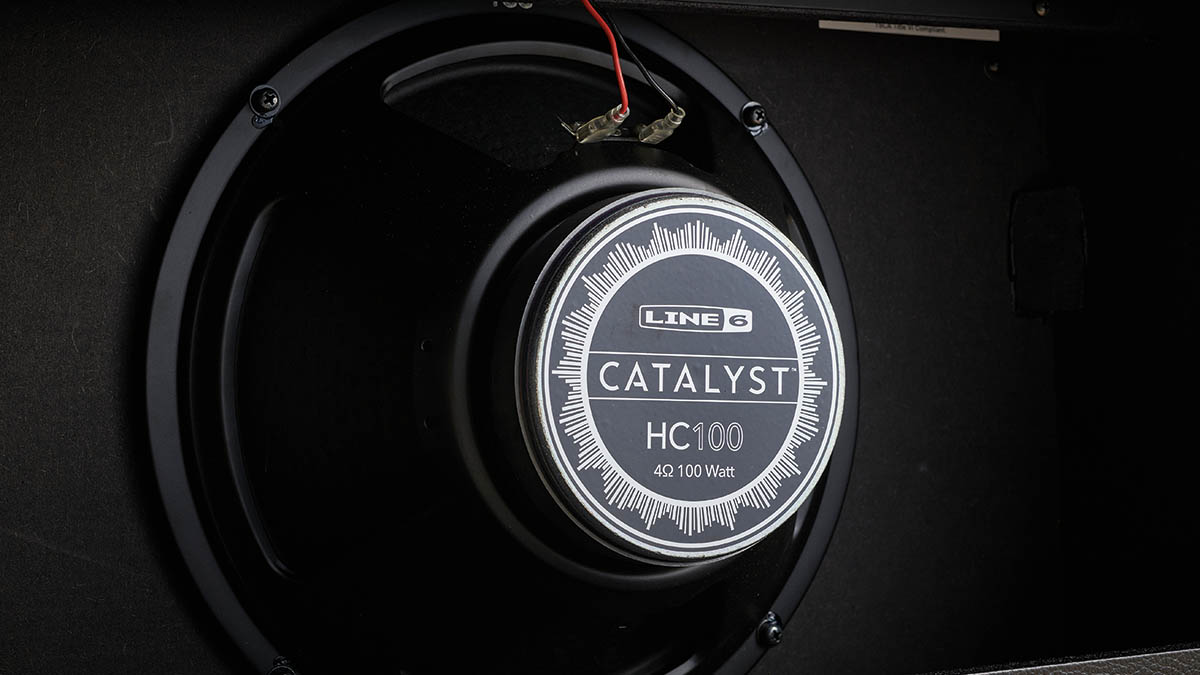Guitar World Verdict
The Catalyst’s sounds and effects are inspiring, pushing you to play better to get the most from them, while the range prices are very affordable. At these prices – and despite stiff competition – we think amp modelling has never sounded so good.
Pros
- +
Excellent HX-quality amp voices and effects.
- +
Familiar controls.
- +
Great choice for live and home/studio use.
- +
Excellent direct output.
- +
Catalyst Edit app.
Cons
- -
Some higher gain sounds are a little muddy and compressed when used with a real band.
- -
No Bluetooth link for the app.
You can trust Guitar World
Line 6 is one of the original pioneers of digital amp modelling, with a history that stretches back to 1996 and the original AxSys 212.
However, it was the arrival of the POD a couple of years later that really cemented the company’s reputation and changed the face of guitar amplification.
While the POD separated the amp modelling and effects technology from speakers and power, Line 6 continued to develop ‘proper amps’, moving on to the Flextone and long-running Spider series. Beside the core ranges, there have been models that pushed the envelope in various directions, such as the Vetta, HD147 and Bogner-designed Alchemist.
Meanwhile, Line 6’s modelling tech has been refined and developed into countless products, including the Variax modelling guitar system, pedals and rack effects, culminating in the award-winning Helix, which has become almost an industry standard for studios and pro players around the globe.
Now a part of the Yamaha group, Line 6 has returned to its roots with the Catalyst: a new range of affordable two-channel modelling amps that combine the latest HX voicing technology with guitarist-friendly features and controls.

Line 6 has always turned out good-looking amplifiers and the new Catalyst is no exception, with a particle-board cabinet trimmed in heavy-duty matt-black vinyl and a smart speaker grille with a subtle pattern picked out in sparkling thread.
The grille and neo-classical logo add a touch of class, giving the Catalyst a smart-yet-restrained visual appeal. The generously deep cab supports a single rear-loaded 12-inch Line 6 HC100 loudspeaker that’s been specially designed for the Catalyst. Its large ceramic magnet indicates there’s no shortage of headroom on this amp.
All the latest guitar news, interviews, lessons, reviews, deals and more, direct to your inbox!
The electronics are contained inside a robust steel U-shaped chassis that’s bolted to the cabinet’s top rear, with one side of the ‘U’ forming the top control panel.

Everything is printed circuit as you’d expect and there are boards for the top and rear panel controls, plus a larger board on the base of the chassis for the power supply and output stage. It’s all been neatly arranged and the assembly looks tough enough to handle live gigging.
Reassuringly, the Catalyst’s control panel looks quite normal for a modelling amp. A single input jack feeds a rotary selector that accesses six original Line 6 amp voices, along with bank patches, effects and reverb types. Next, there’s a Boost on/off switch with a level control, followed by familiar knobs for Gain, Bass, Mid, Treble, Presence and Channel Volume.
Effects and reverb are managed by separate level controls and illuminated button switches that toggle the effects and reverb on or off and enter edit mode when held. A multi-coloured LED indicates which effects are active, while a third button enters tap tempo or activates the Catalyst’s built-in tuner. The last control on the far right is a non-programmable master volume.

The rear-panel features include an Output Power selector offering full or half power, together with a 0.5-watt setting and a mute option for silent recording. Next to this is a USB ‘B’ connector, which hooks the Catalyst up to a desktop for recording or deep editing of patches using the Catalyst editor app.
The Catalyst can be remote-controlled by MIDI. Alternatively, there’s an optional two-button switch that swaps between the A and B channels and toggles the Boost function.
Other connectivity options include an aux in and headphones output, together with a series effects loop and a handy direct out on balanced XLR that has cab emulation and a ground lift switch.
The Catalyst 100 is a smart-looking and well-presented amp that’s ideal for live, studio and home use, and boasts all the features most players need and a clever simplified control panel.
Feel & Sounds
The Catalyst’s voices are original Line 6 amp designs, created using technology from its acclaimed HX library. They’re called Clean, Boutique, Chime, Crunch, Dynamic and Hi Gain, and while there are no direct references to the classic amps that may or may not have been used for inspiration, your ears might pick out echoes of Fullerton, Santa Cruz, Bletchley, Dartford, Seattle (maybe) and Petaluma if you listen carefully.

The realism and responsiveness on offer is impressive. Our favourites are the Boutique amp type, which uses a voice called Aristocrat, and the superb Dynamic, which uses a voice called Kinetic.
With careful dialling in, these virtual amps breathe and react convincingly like proper valve circuits to the extent that there’s little noticeable difference at lower volume settings. Each voice also has its own custom boost function, with a programmable level control and on/off switch.
Used live, some of the higher gain sounds were a little muddy and we’d recommend using the excellent speaker compensated XLR output into a PA to improve definition. Recording with the Catalyst is quite easy using the XLR or USB outputs, with little or no extra treatment needed.

The effects are excellent with warm delays, lush choruses, a Uni-Vibe style effect and rotary speaker models combined with pitch shifting, fuzz and synth options. The level controls don’t seem to have very much adjustment at the lower end of their travel, so the mix is either too little or too much. However, this is easy to correct from the editing app if needed.
The Catalyst has its own effects loop as well, which can be switched into ‘power amp in’ mode if you have an external multi-effects and just need the Catalyst’s power and loudspeaker.
Programming is easy (after a quick read of the manual). The default setting for the Selector knob scrolls through the amp voices, and to access the Catalyst’s bank patches, you hold down the manual button switch for a few seconds before turning the selector.

Similar operations with the effects and reverb buttons access the Catalyst’s 18 effects, arranged in three colour-coded groups of six for delay, modulation and pitch, with a separate group of six different reverb types including hall, chamber, room and spring types.
Having sorted your sound, you save it for easy recall in either the A or B channel in any bank – simply press the A or B buttons on the top panel. Or you can leave the amp in Manual mode, in which case all the knobs and buttons are active.
The relative simplicity of the Catalyst’s controls makes this a great amp to quickly grab a tone and go, while control freaks will be pleased to know the MIDI in socket accepts patch change and continuous controller commands. However, we think the optional two-button footswitch that toggles A/B channels and the boost is all most players will need.

There’s another way to access the Catalyst’s features, including quite a few that aren’t on the control panel, and that’s by using the Catalyst Edit app, which is available for Windows, Mac, iOS and Android. The app hooks up seamlessly via USB and provides a real-time display of the amp’s settings, letting you select amp voices and effects and write them into the amp or save them offline.
You can also download and upload patches from Line 6’s CustomTone marketplace. Extra features include a noise gate and deep editing of amp and effects parameters, with options including pre- and post-amp positioning, sag and bias.
There’s even a slightly tongue-in-cheek option to add in artificial mains hum for authentic vintage gnarliness, but no choice of 50Hz or 60Hz. The app also accesses the Catalyst’s direct output cabinet modelling, giving you a choice of three cabinet types and no less than 16 microphone options.
Verdict
While Line 6’s Catalyst is familiar and straightforward to operate, there’s just enough under the hood to satisfy those who like to tweak things. Consequently, it’s great fun to use, despite a few relatively minor niggles, which could easily be corrected via future firmware upgrades.
That said, the Catalyst’s sounds and effects are inspiring, pushing you to play better to get the most from them, while the range prices are very affordable – the Catalyst 60 is likely to sell on the street for under the magic $300/£250 mark, making it a great ‘first proper amp’ choice.
- Boss Katana vs Line 6 Catalyst: Which should you buy?
Spec
- PRICE: $399 / £465
- ORIGIN: Malaysia
- TYPE: Digital modelling preamp, solid-state power stage
- OUTPUT: 100W into 4 ohms, switchable to half power,
0.5W and mute - VALVES: None
- DIMENSIONS: 487 (h) x
564 (w) x 262mm (d) - WEIGHT (kg/lb): 14.5/32
- CABINET: Particle board
- LOUDSPEAKERS: 1x Line 6 Catalyst HC100 12”
- CHANNELS: 12x presets arranged as 6x banks of 2x A/B patches
- CONTROLS: Channel A/B/Manual switches, amp voice/effects selector, boost level, boost select, gain, bass, mid, treble, presence, channel volume, effects level, reverb level, master volume. Effects/reverb/tap tempo switches, output power switch, fx loop mode switch, ground lift
- ADDITIONAL FEATURES: Balanced XLR line out with ground lift, series effects loop, USB ‘B’ connector, MIDI in, aux in, headphones output. Firmware updates via USB port on bottom of chassis
- FOOTSWITCH: Optional LFS2 2-button footswitch controls channel A/B switching and effects on/off
- OPTIONS: LFS2 2-button footswitch $39/£44
- RANGE OPTIONS: Catalyst 60 (£342) 2x12 Catalyst 200 (£603)
- CONTACT: Line 6
Nick Guppy was Guitarist magazine's amp guru for over 20 years. He built his first valve amplifier at the age of 12 and bought, sold and restored many more, with a particular interest in Vox, Selmer, Orange and tweed-era Fenders, alongside Riveras and Mark Series Boogies. When wielding a guitar instead of soldering iron, he enjoyed a diverse musical career playing all over the UK, including occasional stints with theatre groups, orchestras and big bands as well as power trios and tributes. He passed away suddenly in April 2024, leaving a legacy of amplifier wisdom behind him.



